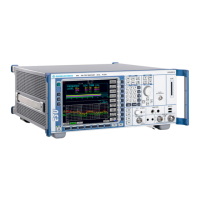Operating Manual 1302.6163.12 - 03 4.101
R&S ESU Instrument Functions
APD Mode
1. The intermittent measurement can be used if the dead time is less than 1 % of the
total measurement time.
2. The probabilities corresponding to all pre-assigned levels shall be measured
simultaneously.
3. In R&S Test Receiver ESU for each of the 625 disturbance levels the probability
of time p
meas
is recorded.
Application of the APD method for compliance testing of microwave ovens
CISPR 11, the current standard for microwave ovens, specifies peak and average
limits for the radiated emission test of microwave ovens. The average (weighted)
value is measured by reducing the VBW (10 Hz) in logarithmic mode. Therefore, the
result does not give a true average value. The linear mode shall be used to obtain
the true average. However, in linear mode, the conventional spectrum analyzer
offers a dynamic range of less than 40 dB. This makes it difficult to make true aver-
age measurements of disturbances from microwave ovens.
The APD measurement is expected as an alternative method to the present
weighted measurement in CISPR 11 with the benefit that the true average value can
be evaluated.
By using the ESU, compliance with the APD limit is determined by measuring the
probability of time p
limit
corresponding to a specified limit level E
limit
. As peak and
average (weighted) limits are already specified in CISPR 11, it is recommended to
use the existing peak limit together with an APD limit point. The EUT is deemed to
be compliant if the measured values are less than both limits.
The problem is how to determine the APD limit point (E
limit
, p
limit
). This can be done
in accordance with [
1
] as follows:
The limit of disturbance level E
limit
is set to the same value as the present average
(weighted) limit.
Measure the APD of the typical disturbance from a microwave oven which is almost
compliant to the present limit.
The average value is calculated from APD measurement results and the probability
of time corresponding to the average value is taken from the APD plot. This value,
the probability of time, is set to the limit, p
limit
.
Repeat point 2. and 3. for various types of microwave ovens to determine the final
p
limit
.
If the preliminary measurement results, obtained by using the maximum hold mode
and peak detection, exceeds the specified APD limit at certain frequencies, then the
APD measurement should be performed at these identified frequencies.
Sampling rate
>= 10 MSamples, when using
an RBW of 1 MHz
10,2 MSamples for RBW = 1 MHz
4,0 MS for RBW = 200 Hz, 9 kHz,
120 kHz
Display resolution of APD
measurement data
less than 0,25 dB 0,128 dB
1. CISPR/A/675/DC: Guidance for applying the APD method to the compliance testing and for developing APD emission limits.

